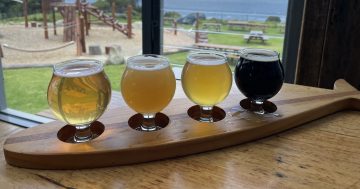
Snorkelling at beautiful Tathra. Photo: SCT/Mitch Lovelock Instagram.
If you’re one of the lucky ones heading to the South Coast this summer, make sure you pack more than your swimmers. For a better appreciation of natural masterpiece of the region, pack your snorkel and take a deep breath.
Professor Emma Johnston, marine ecologist and Dean of Science at UNSW Sydney, says the diversity of nature is actually greater in the oceans than on land.
And this is not only to do with fish, she says “there are a vast array of wildly different animals and plants reflecting billions of years of evolution in our oceans”.
Keep your eyes peeled for the tasselled wobbegong shark or the changing colour of a mourning cuttlefish.
In preparation for the summer, UNSW Science researchers have shared their favourite fascinating creatures to look for while snorkelling and how to find them.
Professor Johnston suggests snorkelling in a marine park sanctuary zone if you’re looking for lots of big fish. For South Coast visitors, there are two of these – one at Batemans Bay and one at Jervis Bay.
“In just 10 minutes underwater, animals from 10 different phyla can be seen – for example, sponges, flatworms, shellfish, sea squirts, roundworms, anemones, urchins, lace corals, tube worms and comb jellies,” she says.

You might know nudibranchs as their other name – sea slugs. Photo: Niki Hubbard.
Marine and behavioural ecologist Niki Hubbard says nudibranchs, otherwise known by their less beautiful name of sea slugs, are a “real underwater treasure”.
Despite their tiny size, Mr Hubbard says they make up for it with magnificent colours and patterns.
Nudibranchs are jelly-bodied molluscs, known for their vibrant appearance. They’re also hermaphrodites, meaning they can mate with any other member of their species.
Out of 3000 species worldwide, there are around 700 in Australia.
But, because of their tiny size (sometimes only a few millimetres long), they can be tricky to spot. Mr Hubbard suggests looking for them in tide pools or while snorkelling in shallows just offshore.
He does offer a bit of advice on how to spot them – many of them have a favourite snack, so it pays to do your research beforehand to pinpoint your search.

Underwater forests are just as beautiful as those on land. Photo: John Turnbull / marineexplorer.org.
For research assistant Madelaine Langley, underwater seaweed ‘forests’ are the most exciting part of our oceans. She says these beautiful forests provide a similarly crucial habit to the tall eucalypts in the Australian bush and hopes people can appreciate their beauty in the same way.
The Eurobodalla’s Nature Coast Marine Group runs a series of school holiday activities as part of its mission to promote the protection, enjoyment and understanding of coastal, estuarine and marine environments on the South Coast.
Night snorkelling at Narooma, kayaking at Moruya, and rock rambles are all on the agenda. Head to the webpage for more details and information to help you identify the creatures you spot on your coastal walks and swims.
















